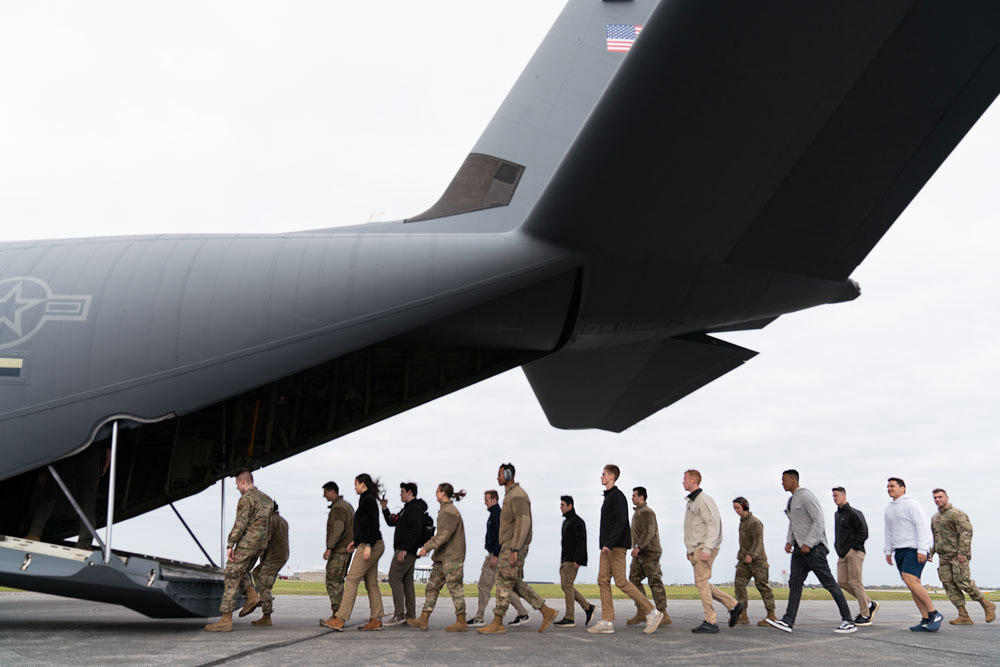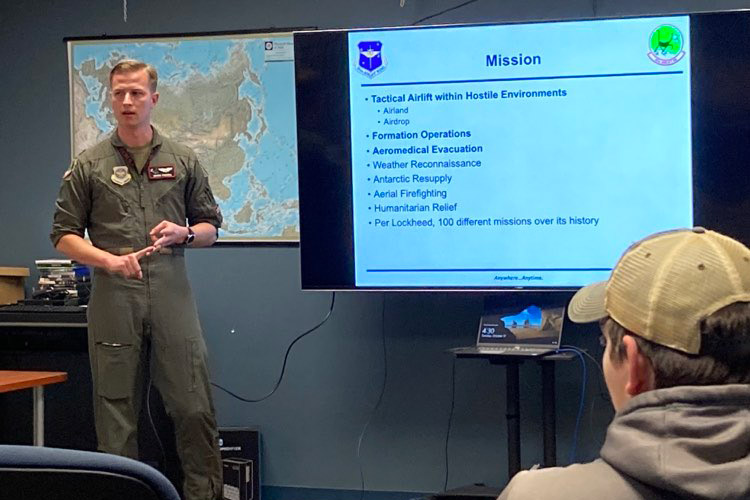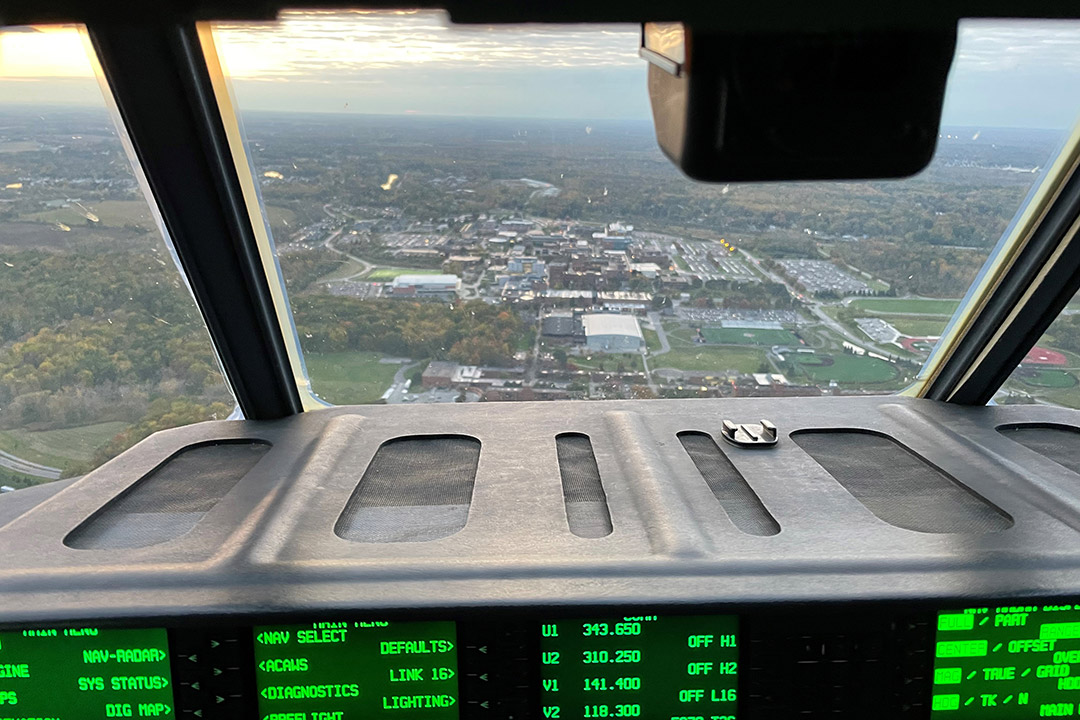RIT alumni showcase success and sky-high aspirations for ROTC cadets
Two graduates, now Air Force pilots, give orientation flight on a C-130
Traci Westcott/RIT
RIT alumni Capt. Chris “Data” Gullo, left, and Capt. Matt “Smoke” Frizzell fly C-130 planes for the Air Force.
There’s a lot to do at Rochester Institute of Technology, but some lessons can’t be learned on campus.
Seventeen RIT Air Force ROTC cadets recently got the opportunity to learn about the C-130J Super Hercules cargo plane with an orientation flight over Western New York and the Finger Lakes.
Traci Westcott/RIT
ROTC cadets embark for an orientation flight on a C-130J Air Force plane at the Frederick Douglass International Airport in Rochester. Two RIT ROTC alumni flew to Rochester from their base in Little Rock, Ark., to allow the students to learn more about the plane, its capabilities, and career opportunities in the military.
The two C-130J pilots with the 41st Airlift Squadron at Little Rock Air Force Base in Arkansas are both graduates from RIT’s ROTC program. Capt. Matt “Smoke” Frizzell ’16 (electrical engineering technology), and Capt. Chris “Data” Gullo ’16 (computer science), helped arrange the opportunity to provide the orientation flight. Space was needed in Little Rock for an upcoming airshow, so they accomplished an off-station training event combined with an orientation flight. Being RIT grads, Rochester was their first choice.
Frizzell, who had not been on RIT’s campus since 2019, said he has fond memories of his time spent in Rochester.
“I loved it,” he said. “RIT really got us to succeed with our academic goals, and the ROTC got us to succeed with our military goals, too. It was a great experience.”
One of RIT’s current cadets, Louis Sullivan of East Amherst, N.Y., said he has wanted to be a pilot since he was 6 years old. He and his father, who was in the Navy, would sit at the end of a runway watching F-18s land.
“I remember seeing their afterburners, and that just did it,” he said.
Sullivan, who is set to graduate this spring, is studying communications and meteorology at State University College at Brockport. Cadets in the RIT detachment of the Air Force ROTC come from many colleges in Western New York. In exchange for their college education, ROTC graduates must commit to four years in the military, or 10 years if they become pilots.
Taking cadets for orientation flights is not uncommon. Frizzell said he had a flight when he was a first-year student at RIT. He earned his pilot certificate to fly small planes before he graduated.
Greg Livadas/RIT
Capt. Matt “Smoke” Frizzell gives RIT Air Force cadets an overview of what his C-130 plane can do, and what they can expect on their orientation flight.
The day prior to their flight, the cadets, and their commanding officer Lt. Col. Chris Denzer met in a briefing room to learn more about the plane, its capabilities, and their mission.
The RIT cadets, along with other Air Force cadets from Cornell University, flew from Rochester’s Frederick Douglass International Airport 70 miles west to Niagara Falls. They headed south along Lake Erie towards Erie, Pa., over the Genesee Valley, and did a low approach at the Geneseo Airport. After that, they flew east over Canandaigua and Seneca lakes, over the Erie Canal Lock 32 in Pittsford, and finally over RIT before landing back at the airport.
They flew as low as 500 feet above the ground, at speeds between 150 and 230 mph. Flying at low altitude is common on missions “to avoid detection and provide an element of surprise,” Frizzell said.
The cadets also got to try “ramp surfing,” standing on the opened ramp on the back of the plane while flying, as parachutists do. The cadets were in a harness so there would be no chance for them to exit the plane.
“It’s a very memorable experience,” Frizzell told the cadets.
They also got tours of the glass cockpit.
Frizzell considers each training exercise a learning experience. “We’ll review what we did right, what we did wrong, and how we could do it better next time,” he said.
Frizzell told them C-130s are a dependable workhorse for the military. They have been around for 70 years and are still being made. Each can carry 128 people, 92 paratroopers, or eight pallets of cargo. The ramp in the back of the plane can be lowered to allow cargo or paratroopers to be dropped.
Lt. Col. Chris Denzer
An aerial view of the RIT campus as an Air Force C-130J with ROTC cadets on an orientation flight prepares to land at the Frederick Douglass International Airport in Rochester.
“One of my favorite things to do is drop a really heavy vehicle out of the back of the aircraft,” Frizzell said. “The largest I’ve dropped is a 32,000-pound Howitzer. It’s definitely an exhilarating experience.”
In the seven years since graduating, Frizzell has served in 48 countries in Europe and Africa, mostly for airlift support, moving cargo, and offering flight training for the country’s joint and allied partners The 97-foot-long planes have been used in combat, in mass evacuations, disaster relief, firefighting efforts, medical transport, even an annual Christmas Drop charitable event in the Pacific.
As the students prepared to board the plane, they were given instructions and safety briefings.
“If you have questions, don’t be afraid to ask them,” Frizzell said. “This should help you decide whether or not you want to fly. But even if you don’t become a pilot, there are so many others on our support team: mechanics, meteorologists, even the Space Force,” which helps maintain the GPS navigation system.
After their flight, Sullivan said he enjoyed seeing residents running out of their homes to get a better look at the huge plane flying over them. And he said the experience was a reminder of why he joined the Air Force.
“The aircraft is a symbol of hope for Americans to feel a sense of safety knowing the Armed Forces will always be between them and danger,” Sullivan said. “Knowing I will be joining that long line of professionals motivates me to be the best I can be as both an eventual officer and pilot.”









